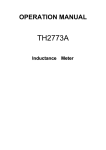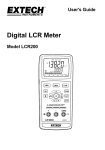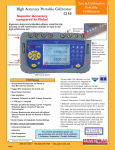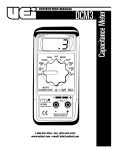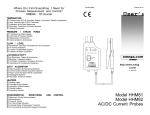Transcript
data†aker 51. Analog Inputs • 1 differential or 3 single ended, can be used in any mix. • Sampling rate 25 samples/sec • Input impedance 1MΩ, or >100 MΩ selectable • Common mode range ±3.5 VDC • Common mode rejection >90 db (110 db typical) • Series mode line rejection >35 db • Sensor excitation of 4.5V, 250.0µA or 2.500mA each channel. • Full, half and quarter bridges, voltage or current excitation. • Multiplexer type: solid state (CMOS) COMMS Port DC Voltage 1 3 DC Current 1 4 Resistance 1 2 1 2 Frequency ±25 mV ±250 mV ±2500 mV ±0.25 mA ±2.5 mA ±25. mA 10 Ohms 100 Ohms 500 Ohms 7000 Ohms 0.1-20,000 Hz *+ – The data†aker 110 mm Source AC DC DC 9V Alkaline Battery 6V Gel Cell Battery Range + Terminal – Terminal 9 – 18Vac AC/DC~ 11 – 24Vdc AC/DC~ 11 – 24Vdc AC/DC~ 6.2 – 10Vdc Alkaline + 5.6 – 8Vdc Lead + AC/DC~ AC/DC~ Gnd Bat. – Bat. – The external 6 Volt gel cell connection provides temperature compensated charging with voltage (6.90V) and current (1A) limiting for a three cell battery, when an external AC or DC power supply is also connected. When the data†aker 51 is powered by a 9V alkaline battery and an external AC or DC source, the 6.9V regulator's (see schematic) output is increased to 10V so that power is drawn from the external source in preference to the battery. 7 N/C 6 TxD 2 N/C 1 Interface Ground Baud Rate s2 off 1200 off 9600 off 300 on 2400 on 4800 ON AA Lithium Battery on lower circuit board +–+ AC/DC Power Input Convert Lamp 1 Battery Alkaline 9V Lead Acid 6V Display Connector 250 mm Caution - To avoid damage use 6 Volt lead acid battery only, ensure correct polarity before connecting the battery AC/DC Power External Battery Connections 6.9V 1000µF Protection Circuit Gnd External AC Power Lead + 11-24Vdc + Bat – Alkaline + Simplified Power Supply Schematic ~ ~ ~ 9-18Vac 0.22Ω Gnd Wiring Battery Wiring Power 6.9V Switch Mode Regulator (–9.2mV/°C) ~ ~ 270 mm DC Gnd. – or External DC Power ~ ~ Gnd + Alkaline + Bat. – – 6.2–10V Lead + External Alkaline Battery Alkaline + – 5.6–8V + Bat. – Lead + External Gel Cell Battery s3 s5 Add. Range off x 0 - 15 on off 0-7 on on 0-7 off x 0 - 15 on x 0 - 15 x = don't care Mux Power s4 permanent on switched off Country Setting The Country Setting determines the default integration period (16.7mS for US and 20mS for others) for the analog to digital converter, and the default date format (see "Date" on page 6). Baud Rate and Address The data†aker 51 RS232 COMMS port baud rate must match that of the host computer. See "COMMS Port" on page 13. If either 300 or 9600 baud is selected, the logger address range is reduced to 0 -7. Multiplexer Power The power consumption of the data†aker 51 can be kept to a minimum if the input multiplexer is powered down while the logger is in the sleep state. For the data†aker 51 this is set using DIP switch s4. The factory preset is for the multiplexers to power down while the data†aker 51 ais sleep. The current saving is approximately 150µA, which is current draw of the 4 CMOS multiplexer integrated circuits (CD4052). See "Multiplexer Powering" on page 15. 75 mm ~~ Range 0 or 1 State 0 to 16 State 65535 Counts 65535 Counts 51 can be powered as follows N/C RxD 3 +5 volts switched Ground 1 Height: 60mm 2 3 Digital I/O Weight: 1.5kg 4 Ground 1 1(out) Power Counters 2 AC/DC 3 Ground G Wake • 4 TTL/CMOS compatible digital input channels for digital state, digital events, low speed counters (10 Hz, 16 bit, presettable). Digital input terminals are shared with digital output channels • 4 Digital open collector outputs rated to 200mA at 30V • 3 high speed counters, (1KHz or 1MHz, 16 bit, presettable). • All analog channels may also be used as digital inputs, with a user definable threshold. Power Supply and Battery also page 15 8 N/C 4 1 Analog Input Digital Inputs and Outputs Channels 4 1 4 3 N/C 5 R Diff refers to differential or double ended channels, and SE refers to single ended channels (see "Glossary" on page 23). Input Type Digital Bit Digital Nibble LS counter HS counter 9 Country s1 US (60Hz) on Other (50Hz) off Shown set to the factory defaults RS232 COMMS Port (Isolated) Resolution 1µV 10µV 100µV 200nA 1µA 10µA 0.5m Ω 5mΩ 50mΩ 500mΩ 0.01% N/C Dip Switch 1 23 45 67 8 For each analog input type, the data†aker 51 provides three decade ranges which are selected automatically: Input Type Channels Range Units Diff SE RS232 COMMS also page 13 The data†aker 51 RS232 COMMS Port is serial RS232 compatible. The output signal level is approximately ±4 Volts, allowing communications over distances in access 100 meters at 1200 baud. Greater distances are possible at 300 baud. The maximum practical distance is also dependent on the host computer's RS232 characteristics. (Note: the RS232 "standard" specifies 2000pF maximum cable capacitance, and no maximum distance). The data†aker 51 RS232 COMMS Port is electrically isolated to 500V. Address s5 0 off 1 off 2 off 3 off 4 off 5 off 6 off 7 off 8 on 9 on 10 on 11 on 12 on 13 on 14 on 15 on See text to right Each model in the data†aker data logger range has a number of characteristics that differentiate it from the other models. This Appendix describes these characteristics for the ON Introduction Page A1 DT 51 1 23 45 67 8 Appendix — data†aker s6 s7 off off off off off on off on on off on off on on on on off off off off off on off on on off on off on on on on s8 off on off on off on off on off on off on off on off on data†aker 51 Address The data†aker 51 can be given an address, despite the fact that the logger does not support networking. The address of a data†aker 51 can be used for ◆ identification in the STATUS or STATUS1 commands (see "STATUS" on page 10) ◆ identification of returned data if /L Address Switch is enabled (see "Swityches - /L" on page11) If 300 or 9600 baud rate is selected, then the address range is limited to 0 - 7. Power Consumption The data†aker 51 will consume very little power if it is allowed to sleep. Less power is consumed if the data†aker 51 is powered through the battery terminals, rather than through the AC/DC terminals, because the battery charger circuit draws additional current, especially if it is charging a depleted battery. Power Source battery battery AC/DC AC/DC AC/DC AC/DC Condition awake sleep awake awake & charging sleep sleep & charging Current (typical) 100mA 0.36mA 105mA 600mA 5mA 500mA
